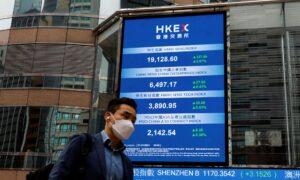Although Beijing is struggling to attract more overseas funds to boost its flagging economy, foreign investors in Asia are growing increasingly wary of China due to its unpredictable property market, weak consumer and business sentiment, and geopolitical tensions.
Instead, India is starting to look more attractive in this context. This is a key message emerging from experts tracking recent foreign institutional investment (FII) trends in Asia.
Asia-focused funds are paying close attention to the contrasting economic landscapes of these two neighboring economic powers, they said, while some are even considering Vietnam and Indonesia as emerging alternative investment destinations in Southeast Asia.
“Despite inflows, funds [from the U.S.] retain their small underweight on mainland China, [and] they have instead increased their positioning in India,” said HSBC Global Research in a note on May 27.
The British financial services group noted that while active Asia funds from the United States may have refrained from reducing their exposure to mainland China since February, they have still been net sellers of mainland Chinese equities this year.
Asia funds have a mandate to invest in Asia, excluding Japan and Australia.
According to HSBC, based on May 23 data, its proprietary framework of mutual funds’ positioning shows that funds that have invested with the goal of earning a profit over a few years (long-only) “have cautiously increased their holdings of mainland Chinese equities” by 1 percentage point.
“This has fallen short of the rise in mainland China’s weight in the underlying benchmark, and with this, [the] funds have retained their small underweight on the market,” said the note. “Taiwan and India [on the other hand] witnessed an increase in exposure.”
Bloomberg, citing Nomura Holdings research, reported on Monday that 72 percent of 50 big emerging market funds have an underweight position in Hong Kong and mainland Chinese equities.
This is expected to persist, says Tariq Dennison, GFM Asset Management LLC, a U.S.-registered investment adviser.
“For many U.S. investors looking at 15 years of U.S. stocks outperforming almost every non-U.S. stock market, it’s already hard enough to consider allocating to any stocks outside the U.S. and of non-U.S. stock markets,” Hong Kong-based Mr. Dennison told The Epoch Times.
Underperforming Economy
While revising China’s economic growth at 5 percent, up from its earlier forecast of 4.6 percent, the International Monetary Fund (IMF) cautioned on Wednesday that the second-largest economy is heading for a slowdown from 4–5 percent in 2025 to 3.3 percent by 2029.The aging population and slower productivity growth were the two biggest reasons for the struggling economy, the IMF said, suggesting that China would need to boost productivity to continue with economic reforms.
Addressing a press conference to mark the conclusion of the global lender’s annual review of China’s economic policies, IMF Deputy Managing Director Gita Gopinath also noted that achieving high-quality growth, a key focus of Chinese leader Xi Jinping, will require structural reforms to counteract headwinds and address underlying imbalances.
“Overall risks to the outlook are tilted to the downside, including from a greater or longer than expected property sector adjustment and increasing fragmentation pressures,” she said.
In its latest regional outlook summary, the Economist Intelligence Unit (EIU) reiterated that China is undoubtedly confronting a growth challenge and projects a more pessimistic outlook.
“We forecast real GDP growth in China to slow by 0.5 percentage points to 4.7 percent in 2024,” the EIU noted in the report, adding that consumer sentiment,in particulary, will remain fragile.
According to the Economist Group’s research wing, despite pressure to boost growth, the Chinese leadership will maintain a cautious approach to addressing pressing issues such as property sector stress and local government debt. This too could undermine investors’ confidence, it noted.
Geopolitical Concerns
According to fund managers, flashpoints in Asia, such as recent political tensions in the South China Sea and Taiwan, as well as fragile U.S.-China relations, pose persistent threats to FII sentiment.“Heightened tensions between China and the West, particularly the U.S., over issues like Taiwan, human rights, trade, and potential tariff wars create an uncertain environment that makes investors cautious on China exposure,” said Michael Ashley Schulman, chief investment officer at the California-based Running Point Capital Advisors.
But “the American rhetoric against China aside,” says Devina Mehra, co-founder of First Global, an India and UAE-based global asset manager, “the Chinese stock markets have been down for so long that fund managers are still skeptical about it.”
According to an April report by Morningstar, China equities have largely underperformed global financial markets, including other emerging markets, for about three and a half years, up until March 2024.
For instance, the Chicago-headquartered financial services company cites that in 2023, the benchmark S&P 500 Index rose 22 percent, while China’s CSI 300 Index fell 13 percent, both measured in euros.
Moreover, the Morningstar China Index NR lost 42 percent of its value from the end of January 2021 to the end of March 2024, whereas the Morningstar Global Markets Index gained 40 percent, and the Morningstar Emerging Markets Index increased by 4 percent, also in euro terms.
ASEAN, India Rise
With Chinese growth slowing, fund managers are seeking to capture the growth potential of India and its Association of Southeast Asian Nations (ASEAN) peers, Vietnam and Indonesia.“India’s long-term story has several contrasts with China. India is seen as a country that is working with the West rather than in opposition. Hence, foreign companies are much more likely to invest in India and partner in long-term developments,” says Gary Dugan, CEO at The Global CIO Office and a foreign investor in the United States and China.
“India is going through that stage of its economic development, which in the case of China led to some outsize returns from the stock market,” he adds.
According to the EIU, India’s projected growth of 6.5 percent for the 2024–25 fiscal year (April–March) will make it the fastest among major global economies. This momentum will primarily come from government investment and the services sector, with private consumption and exports also gaining traction.
The EIU predicts that India will increasingly attract the global supply chain as it strives to establish itself as a leader among emerging economies through a non-aligned foreign policy and expanding market size.
In April, the IMF raised India’s growth forecast for the same fiscal year from 6.5 percent to 6.8 percent, citing strong domestic demand and a growing working-age population.
The Reserve Bank of India, the country’s central bank, estimates that the economy will grow by 7 percent in the current financial year, which began on April 1.
Mr. Dugan told The Epoch Times that international investors increasingly view Indian equities as a must-have in their global portfolios. “More and more investors are making a distinct investment in Indian equities, compared to the past, when their investment in India would have been through a general emerging market fund.”
According to HSBC’s Monday note, though, while Mainland China witnessed absolute net FII flows of $15.7 billion from February–May 23, India saw a net inflow of merely $100 million.
FIIs have also reportedly been consistent sellers of Indian equities in May.
But that could be due to the fact that the “excitement about India had surpassed a little ahead of its actual advantages over other emerging markets,” according to Mr. Dennison.
Still, “many foreign investors may be hesitant to make large long-term direct, private equity, or private credit investment commitments to China where capital could be tied up for years [due to its faltering economy],” Mr. Schulman told The Epoch Times.
“Some of this capital has already shifted to India, Vietnam, and Indonesia where growth prospects remain high and political perceptions are friendlier.”
The IMF has projected that Vietnam will grow at 5.8 percent in the calendar year 2024, while Indonesia’s GDP growth would be slightly lower at 5 percent.







